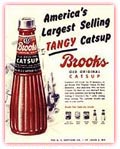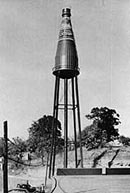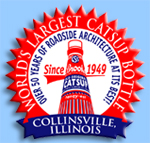

| The
Rich and Tangy History of the World's Largest Catsup Bottle! |
|

The struggling little plant went through a few different owner/operators until 1907 when the Brooks brothers, Everett and Elgin, took over. They operated under the name of Triumph Catsup and Pickle Company. 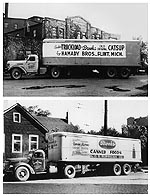 The ghost sign
image of the company
name can still be seen on the north wall of the old
brick factory. Soon
the name became Brooks Tomato Products Company. The ghost sign
image of the company
name can still be seen on the north wall of the old
brick factory. Soon
the name became Brooks Tomato Products Company. In 1920, the brothers sold out to American Cone and Pretzel Company. Then in 1933 the G.S. Suppiger Company purchased the plant. The Brooks brand name was retained by each new owner. The product line had acquired an excellent reputation over the years. The catsup factory had great success, surviving the Great Depression, and growing by leaps and bounds through the 1940s. 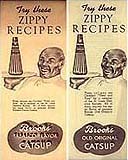 The plant produced much more than catsup, including chili
beans,
spaghetti, hominy, soups, and other sauces. The plant produced much more than catsup, including chili
beans,
spaghetti, hominy, soups, and other sauces. The "Brooks Tabasco Flavor Catsup," as it was named, was extremely popular. So much so that the McIlhenny Tabasco Company threatened a lawsuit claiming the term "tabasco" was their copyrighted property. Not wanting to fight a costly legal battle, the Suppigers changed the name to "Brooks Old Original Tangy Catsup." The change can be seen on these two vintage recipe brochures. 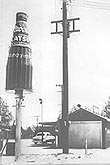 The company
promoted its product well. In Belleville and St. Louis, big 12-ft high
Brooks catsup bottles, adorned with neon,
slowly
rotated
while perched
on sign poles. The company
promoted its product well. In Belleville and St. Louis, big 12-ft high
Brooks catsup bottles, adorned with neon,
slowly
rotated
while perched
on sign poles.
Brooks was even advertised in Sportsman's Park, home of the St. Louis Cardinals and the St. Louis Browns baseball teams. At one time it was America's #1 seller among tangy catsups, and in the greater St. Louis area it out sold all other brands combined by 2 to 1.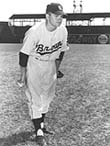 In
1947, records show that the
W.E. Caldwell Company of Louisville, Kentucky, entered a contract to
build
the 100,000 gallon water tower. Final drawings were approved in 1948
and
the World's Largest Catsup Bottle was completed in October of
1949. In
1947, records show that the
W.E. Caldwell Company of Louisville, Kentucky, entered a contract to
build
the 100,000 gallon water tower. Final drawings were approved in 1948
and
the World's Largest Catsup Bottle was completed in October of
1949. A water tower was
needed for plant
operations and to supply water to the new fire protection sprinkler
system.
Gerhart S. Suppiger, then president of the company, suggested the tower
be built in the distinctive tapered shape of their catsup bottles.
In 1959,
Brooks Foods merged with P.J. Ritter Company and the Suppigers sold
their
share of the company in 1960. Catsup bottling operations were moved to
Indiana in the early 1960s, and the old factory was then used as a
warehouse.
Read more on our "Restoration" page and for a more detailed
look, check out the News and Information Archive. |
|
 Custom Search
|


